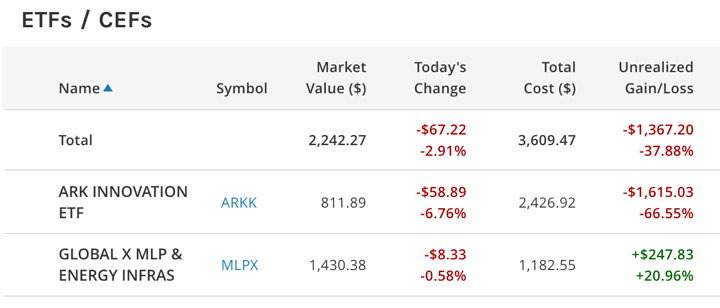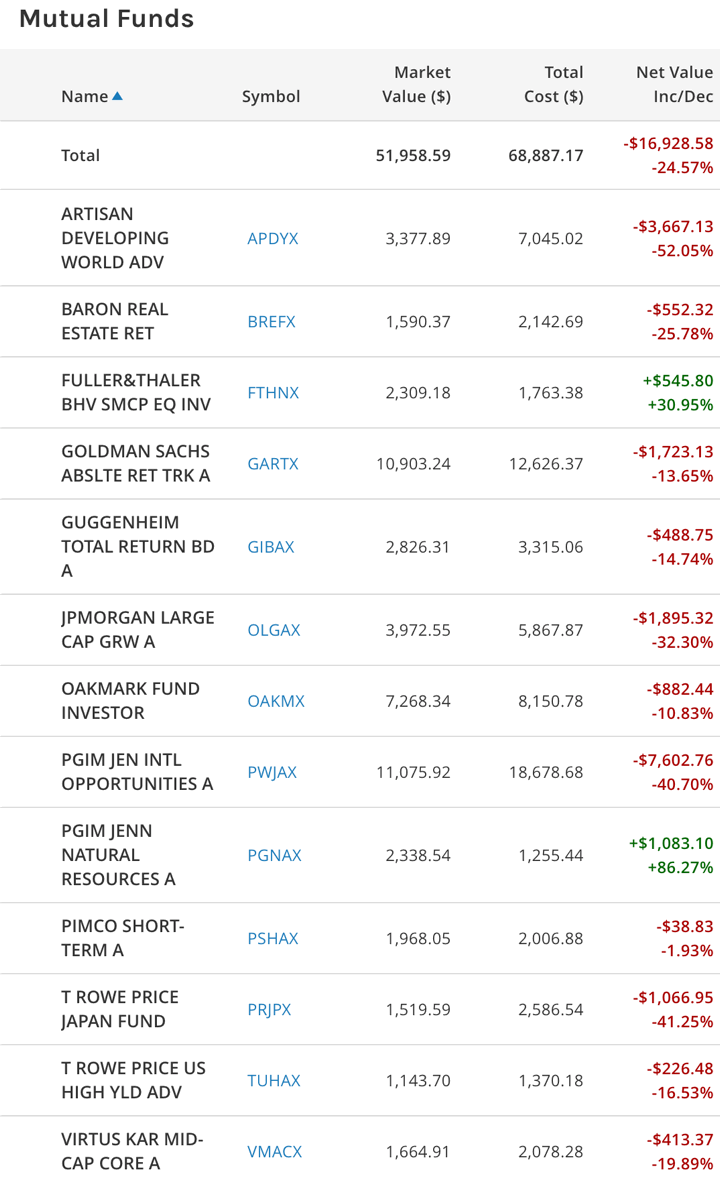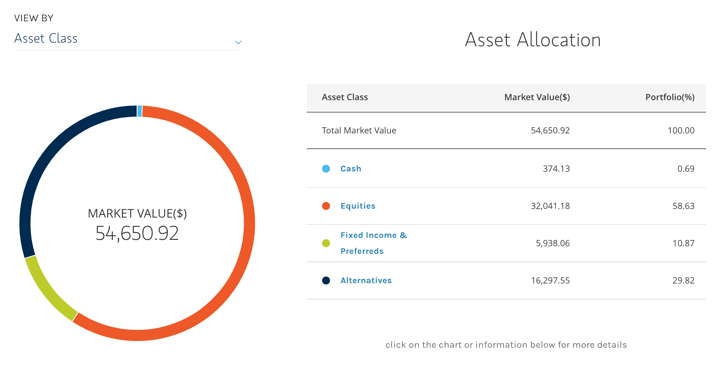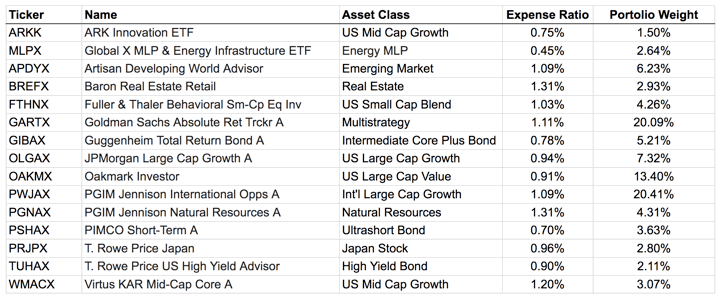Although I enjoy managing my own investments, I’ve generally avoided managing other people’s money. That always felt like such an important responsibility to take on. Below is the real investment portfolio of an older family member (over 75) that is professionally managed by an large “brand name” financial firm. Understandably, the recent market volatility has hurt the balance and there is some concern, so I took a look.
Before opening up the statement, I joked to myself “There better not be that ARK ETF in there!”…. and there it was. Down 66%! 😱 Deep breaths! My thoughts went to the four basic steps to performing emergency first aid:
- Assess the situation
- Plan for interventions
- Implement first aid
- Evaluate the situation.
Here are some anonymized screenshots (with permission) that show holdings, balances, performance, and rough asset allocation breakdown.




Why in the world does this portfolio only have 10% in bonds, at least according to the pie chart above? What exactly are those “alternatives”? I created a Google spreadsheet and started collecting more data from Morningstar:

The Goldman Sachs “multistrategy” fund turns out to consist of roughly 50% net stocks and 50% net cash/bonds. So the overall asset allocation is about 80% stocks and 20% bonds. Perhaps they confused the “age in bonds” rule of thumb with “age in stocks”? 🤔
I don’t know all the details and communications that took place before the creation and implementation of this portfolio, but my first impression is not positive. In addition to an overly-aggressive asset allocation, I see a mishmash of high-cost mutual funds. There isn’t a single penny in a low-cost index fund as a core holding! I don’t believe that you need 15 different funds to be “diversified”. While a relatively small holding, the fact that ARK ETF holdings are down 67% also means they decided to buy in after all of the initial outperformance. In other words, performance chasing.
Speaking of performance, the portfolio is down 25% from the initial purchase amounts. That’s seems like a lot for someone in their 70s, and we haven’t even technically hit a bear market in the S&P 500 yet.

 The Best Credit Card Bonus Offers – 2025
The Best Credit Card Bonus Offers – 2025 Big List of Free Stocks from Brokerage Apps
Big List of Free Stocks from Brokerage Apps Best Interest Rates on Cash - 2025
Best Interest Rates on Cash - 2025 Free Credit Scores x 3 + Free Credit Monitoring
Free Credit Scores x 3 + Free Credit Monitoring Best No Fee 0% APR Balance Transfer Offers
Best No Fee 0% APR Balance Transfer Offers Little-Known Cellular Data Plans That Can Save Big Money
Little-Known Cellular Data Plans That Can Save Big Money How To Haggle Your Cable or Direct TV Bill
How To Haggle Your Cable or Direct TV Bill Big List of Free Consumer Data Reports (Credit, Rent, Work)
Big List of Free Consumer Data Reports (Credit, Rent, Work)
A lot of questions come to mind. Are these figures YTD? If not, how old are these positions? I assume they are new given the losses (we just had a 10 yr bull market). Maybe they are churning the account? I agree, too many funds with low balances. Probably a load for some of those mutual funds too.
I’m not exactly sure on the initial purchase date but I agree it does look pretty recent.
Yes, those A shares mutual funds had front-end loads, I need to look add that data to the spreadsheet.
Is this their only investment portfolio? If so, the person who put it together should be taken out back and [given another job] because this is almost criminal.
No, it wasn’t their only portfolio, it was one of a few IRAs I believe. However, unless they told the advisor this was only for a future inheritance or something, I can’t see how this is appropriate for someone in their late 70s.
This is a sad, all too common story. This happened to my mother and it’s why I am quite reluctant to have anyone to manage my money.
I view this as a form of elder abuse. The intent of the person managing this portfolio (from this large “brand name” financial firm) is not to act as a fiduciary, but to take as much of the victim’s money as they can get away with in a legal fashion. It appears to have all of the classic strategies such as portfolio complexity, breeding dependence, and I’d bet more than necessary churn.
One of the next steps for you or this family member is to wrest investment control away from this crook and the large “brand name” investment firm that supports this behavior. That may not be easy. Jonathan, I’m sure you could pick two or three ETFs at Fidelity or Vanguard that would be much more appropriate for someone over age 75. Good luck!
I agree that they are taking advantage of people under the guess of “this is just what we do”. I would guarantee that if I asked them “Did you know they took out a 5% front end load on every investment, such that if you gave them $10,000 they would take $500 immediately and then invest the remaining $9,500 in a mutual fund with higher-than-average costs?” the answer would be no.
How do you know from looking at this cart that they too out a front-end load on the investment?
Mutual funds can have different share classes, each with different ticker symbol. I plug it into Morningstar, which tells me the share class usually and the commission structure. A shares are usually front-load.
Total disaster is all I can say.
Could you also provide information about how much they are paying in fees?
Not sure about the fees. They are certainly already being compensated via the front-end loads on those mutual funds.
That is shocking. It appears this portfolio was put together simply to wrack up mutual fund load charges and/or fees for the “large ‘brand name’ financial firm”.
Do you know if a single individual made the decisions, or if it was some kind of diversification tool, or “robo-advisor”?
This is just a $50k balance which is relatively small peanuts for a wealth management firm, so I’m assuming it is just some sort of managed model portfolio that took 10 minutes to whip up.
I’m guessing all of those funds pay commissions back to the advisor?
You would guess right, at least for most of them. Every one that ends in “A” has a front-end load.
This portfolio serves the advisor, with high fees, not the client. What is the professional designation of this advisor? One that requires a fiduciary duty or the lower standard of “suitability” (which it also seems to fail)? Unfortunately, this is a common scenario I have seen over the years. These types of advisors love to put a client in a huge number of expensive funds, which often overlap in market cap/category, under the guise that more is better. By making it look complex with all these funds, the client perceives this as better and thinks the advisor is adding great value, which, clearly, they are not (except to themselves). Was this person also sold some terrible, complicated, high-commission insurance product? That’s another sad but common scenario.
I looked at a portfolio for a friend who are in their late 50s and they had 36 mutual funds plus paying 2% manager fees. I told them they don’t need 36 funds and should check into how much they pay in fees. They didn’t like my answer. I didn’t say another word.
This??. I had the same situation with a family member. I laid out all of the expenses and fees out on a spreadsheet to show them how they were being fleeced. Same deal as this article: class A funds amounting to $80 in initial fees and large annual fees. In the end their trust of the Morgan Stanley name was stronger than reason. We haven’t spoken about it again and I don’t plan on bringing it up.
If you don’t want to be fleeced, just put money in a target retirement index fund.
You will do better than the pros and there is nothing to do
It would be very interesting to know what would be the outcome if they had followed your strategy Jonathan:
Put everything in a few index funds.
Was the “brand name” investment firm commission-based or fee-only? (I’m guessing you don’t want to “name and shame” the firm.) I assume the former.
There is definitely a lot of mutual funds with big front-end loads in the portfolio, and I’m not sure if they charged something on top of that.
I suppose that I am choosing not to name the firm because I don’t always think it’s the firm that matters. Every major firm has hundreds of advisors under their umbrella, and I do believe that some are better than others. I would say that this portfolio could exist at Merrill Lynch, Morgan Stanley, UBS, Ameriprise, and so on. At the same time, the advisor needs to get paid somehow, and so does the firm. I doubt any advisor at “brand name firm” charges fee-only by the hour.
I have the same question as the other Jim, asking if this is their only money.
If this is their retiremenet savings and all they have to live off (plus probably social security) then this is not good at all to have such high % in equities.
BUT If the person has a pension + social security + paid off house and is pretty much set as far as retirement savings and income / expense needs and the money shown here is like just ‘extra’ money they do not need to live off then its possibly just fine.
Also depends on the indiviuals risk tolerance. I would never put my very risk intolerant parent into those invsetments. But it would be ok for my uncle who likes to take risks more.
Yes, I agree, the 80% stocks is possibly fine if they are all set otherwise and this is money was earmarked for the next generation. But… unlikely in this case based on my limited knowledge. I’ll have to try to find out more.
I’ve only heard of a few of those mutual funds. Yikes!
I don’t even mind the ARK too much because it looks like it was 5% of the portfolio. I’m with Jim though, if this is all the money the person has, I hope there’s a great pension, paid off real estate, and a healthy social security.
She does have other assets, but these funds were most likely to be used for long-term healthcare needs and such. I definitely feel like I need to “stop the bleeding”!
As you have with us, share a copy of Bill Schultheis’ book, “The Coffeehouse Investor” to give your relative a quick and clear education on wise/simple/inexpensive investment management. Then connect them with a fee-only fiduciary advisor who can put them into something akin to the Coffeehouse portfolio, the Lazy Portfolio or Paul Merriman’s Ultimate Buy and Hold portfolio. (Preaching to the choir, I know!)
This portfolio has way too many different mutual funds hold way too many stocks: 1. might as well invest the portfolio in different individual stocks; 2. the funds charge high management fees camouflaged behind the cost per share; 3. a portfolio management fee is on top of the funds’ camouflaged management fees; 4. no fund manager can keep track of so many mutual funds and so many stocks in the funds, much less keep up with so many diverse clients.
This portfolio is invested in the wrong ETFs which are speculative and charge high management fees. This portfolio should have” market index” ETFs of very low cost management fees, and which track S&P 500 index and Total Stock Market Index, and Russell 2000 Index.
The mutual funds of which there are too many to keep track of probably make capital gains distributions to their investors which are subject to income tax, even when the investors have paper losses. The investors take all the risk of investment, and all the income tax liabilities, and pay all management fees.